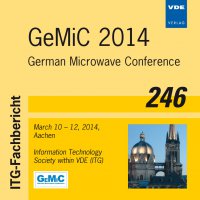Present State-of-the Art of the Worldwide Fusion Gyrotron Development
Konferenz: GeMiC 2014 - German Microwave Conference
10.03.2014 - 12.03.2014 in Aachen, Germany
Tagungsband: GeMiC 2014
Seiten: 4Sprache: EnglischTyp: PDF
Persönliche VDE-Mitglieder erhalten auf diesen Artikel 10% Rabatt
Autoren:
Thumm, Manfred (Karlsruhe Institute of Technology, Germany)
Inhalt:
Progress in the worldwide development of high-power gyrotrons for magnetic confinement thermonuclear fusion plasma applications is presented. Gyrotron oscillators are used for electron cyclotron heating (ECH), electron cyclotron current drive (ECCD), plasma stability control and plasma diagnostics. After technology breakthroughs in the research on gyrotron components in the 1990’s, significant progress has been achieved in the 2000’s, in the field of long-pulse and continuous wave (CW) operation for a wide range of frequencies. At present, the development of 1 MW-class CW gyrotrons for the tokamak ITER (170 GHz), the stellarator Wendelstein 7-X (140 GHz), and the tokamaks DIII-D and JT-60SA (110 GHz) has been very successful in EU, Japan, Russia and USA. The Japan 170 GHz ITER gyrotron holds the energy world record of 2.88 GJ (0.8 MW at 1 hour pulse duration). For this progress in the field of high-power long-pulse gyrotrons, innovations such as the realization of high-efficiency stable oscillation in very high-order cavity modes with low ohmic losses, the use of single-stage depressed collectors (SDCs) for energy recovery (efficiency enhancement and simpler power supplies), highly efficient internal quasi-optical mode converters (low level of internal stray radiation) and synthetic diamond windows have essentially contributed. The total tube efficiencies are around 50% and the purity of the linearly polarized fundamental Gaussian output mode is 97% and higher. Power modulation technologies for stabilization of neoclassical tearing modes (NTMs) have proceeded. Future prospects of advanced high-power fusion gyrotrons are in the areas of two- and three-frequency tubes, fast step-wise frequency tuneability, higher unit power (coaxial cavities) and higher frequencies for more efficient plasma stabilization and non-inductive current drive as well as reliability, availability, maintainability and inspectability (RAMI) for next step fusion power stations. The GYCOM step-tuneable 1 MW gyrotron for ASDEX Upgrade employing a broadband travelling-wave-resonator window (with 2 diamond disks) operates at 105, 117, 127 and 140 GHz. The EU 170 GHz coaxial-cavity gyrotron prototype achieved in ms pulses the power of 2.1 MW at 46% efficiency and 96% Gaussian mode purity.


